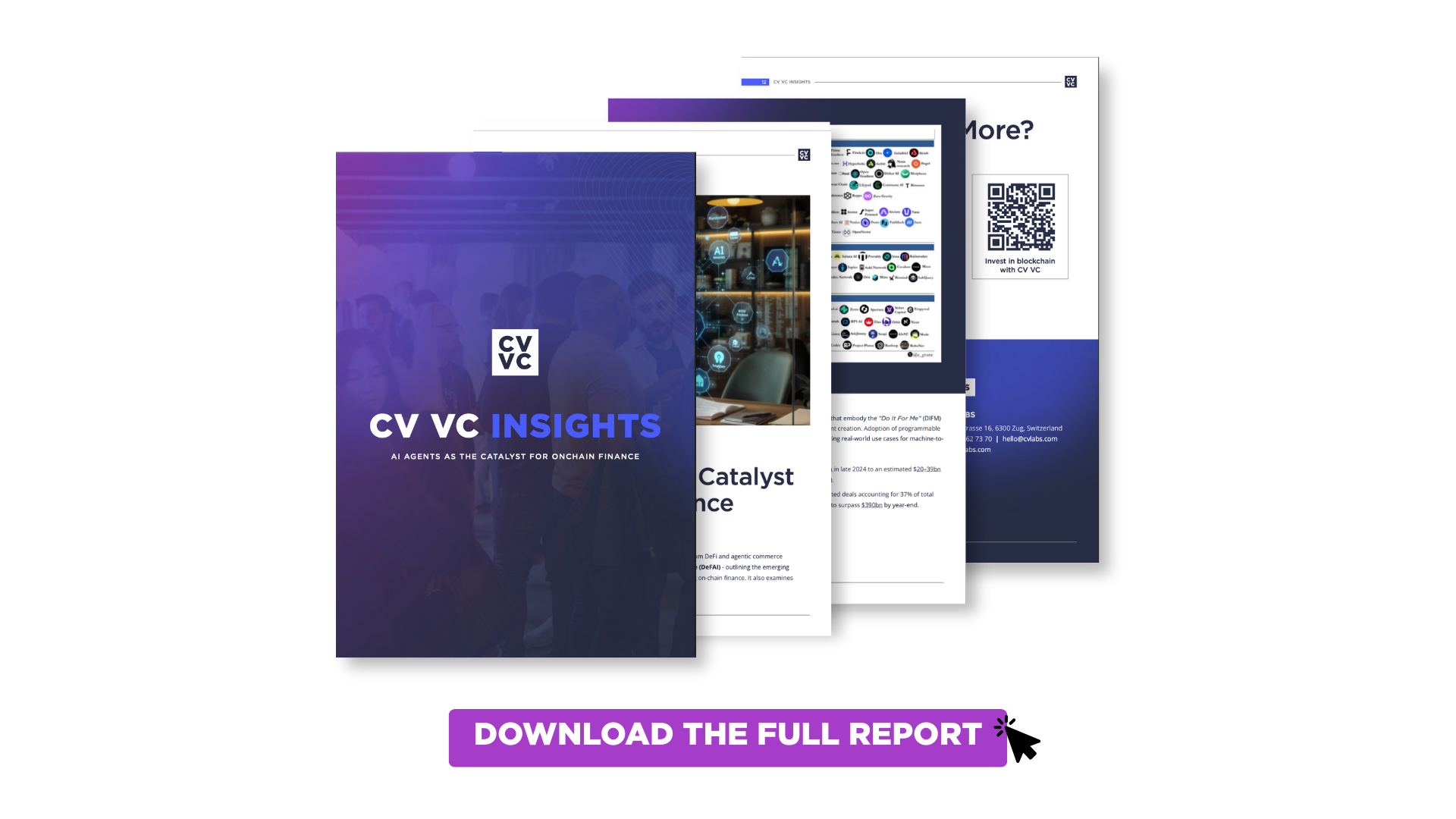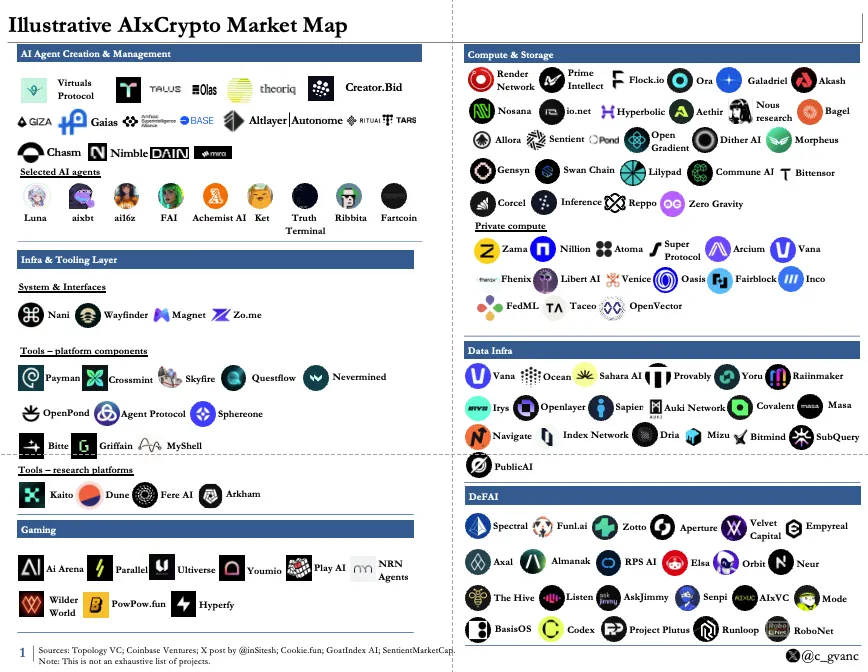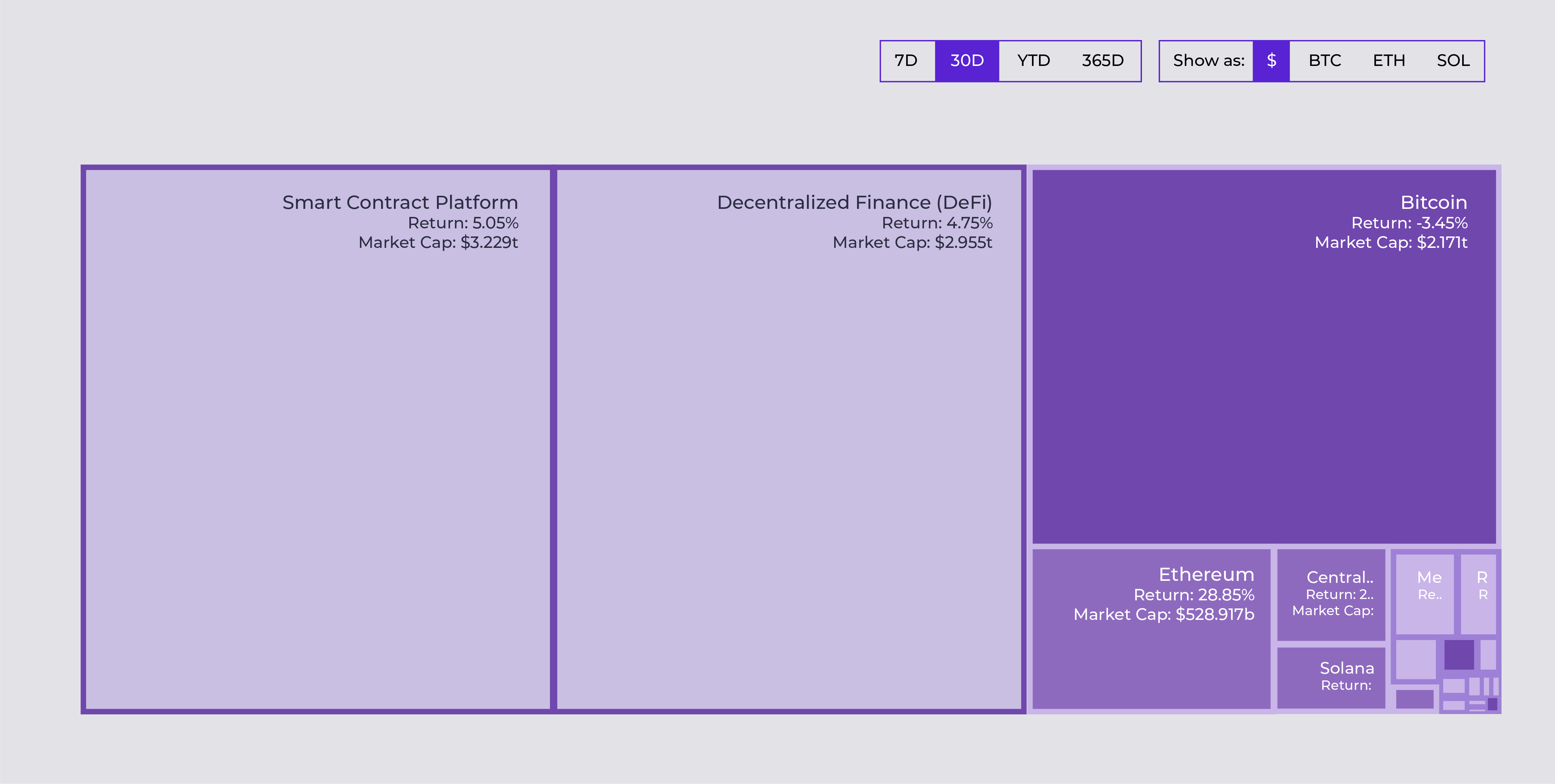CV VC Insights: AI Agents as the Catalyst for Onchain Finance

Introduction
The convergence of AI and crypto is accelerating, spanning use cases from DeFi and agentic commerce to decentralized AI. This piece focuses on AI in Decentralized Finance (DeFAI) - outlining the emerging landscape, current market trends, and the role of AI agents in unlocking on-chain finance. It also examines implications, risks, and areas of potential investment.
Sector & Market Analysis
Sector Overview
The AI agent sector is evolving rapidly. What began as pre-programmed bots is now advancing toward autonomous software capable of planning, executing complex tasks, and achieving goals without human input. Powered by Large Language Models (LLMs), these agents connect with tools, APIs, and digital systems - positioning them as versatile participants in online economies.
In finance, this evolution is giving rise to Agentic Finance, where AI can manage funds, execute trades, or provide personalized financial advice. The implications for DeFi are particularly significant. Today, wallet management, multi-chain navigation, and smart contract interactions remain complex, limiting DeFi adoption to a small fraction of centralized exchange (CEX) volumes. AI agents can abstract away this friction, making DeFi accessible to millions more users.
This trajectory points toward an Agentic Web, where AI-powered participants operate directly on blockchain rails - driving economic activity on behalf of people while radically simplifying the user experience.
Bringing more users on-chain matters: it broadens access to financial products, strengthens transparency, and restores sovereignty to individuals. At the same time, AI is embedding itself across verticals, from financial services and supply chains to gaming and social platforms. Finance, however, remains one of the highest-impact frontiers.
Market Landscape
The convergence of AI and crypto is rapidly emerging as one of the most dynamic frontiers in technology. The space spans foundational infrastructure (compute, data, and storage), agent frameworks, tooling, and consumer-facing applications such as DeFi, payments, and gaming.
While still early, the AI x Crypto ecosystem is evolving quickly: autonomous AI agents are increasingly deployed on blockchain rails to transact, process data, and create content. The market map illustrates the breadth of innovation across agent creation, compute, storage, and financial applications.

A defining trend is the rise of Agentic AI systems - autonomous agents that embody the “Do It For Me” (DIFM) economy by executing tasks such as trading, data processing, and content creation. Adoption of programmable stablecoins (e.g. Stripe’s USDB) and Coinbase’s x402 protocol is accelerating real-world use cases for machine-to-machine value transfer.
- Market Growth: The AI x Crypto market has expanded from ~$14bn in late 2024 to an estimated $20–39bn by mid-2025, with forecasts projecting ~$47bn by 2034 (CAGR 28.9%).
- Funding Momentum: VC funding reached record levels, with AI-related deals accounting for 37% of total investments in 2024–2025. AI’s overall market trajectory is expected to surpass $390bn by year-end.
Heatmap data from DeFiLlama highlights strong sector performance: DeFAI sits as the second-largest growth segment after L1 blockchain infrastructure based on 30-day market-cap weighted price performance.
30D Market-Weighted Price Performance by Category, denominated in $-dollars.

Notes: MCap-Weighted Category Performance: This shows how a category of coins has performed over the chosen time period and in the
selected denomination (e.g., $, BTC).
- Methodology: Calculate the percentage change for each individual coin in the category. Weigh these changes based on each coin’s market capitalization. Average these weighted changes to get the overall category performance.
Key Developments (Past Year)
Hype to Utility Shift: Moved from “degen” memecoin-like experiments (e.g., early 2024 agent launches on Virtuals) to functional platforms with real TVL; agents like ARMA (Giza) achieving 100% profitable DeFi yields, AI hedge funds like Daos.fun managing portfolios autonomously or Velvet Capital (asset management agents); Spectral or Zotto (AI driven trading); Aperture (cross-chain liquidity) automating financial transactions.
Sector Expansion: Sector market cap surged from ~$14bn in late 2024 to $20–39bn by mid- 2025; VC funding hit record 37% of deals, with autonomous agents leading growth; corporate mentions of agentic AI jumped 17x, signaling “Do It For Me” economy mainstreaming.
Infra Maturation: Distributed training viable for small/RL models (e.g., NousResearch, Prime Intellect), but frontier models 18+ months away; privacy tools (e.g., Nillion, Zama) and verifiable inference (zkML via OpenGradient) became dedicated categories to combat hallucinations and security risks.
DeFi & Fintech Integration: Agents automated yields and trading (e.g., Griffain as “AI app store”); fintech bridges like Stripe’s USDB and Coinbase’s x402 enabled seamless payments; RWA/GPU tokenization accelerated under procrypto policies.
Trustless Agents (ERC-8004): New Ethereum standard giving AI agents on-chain Identity, Reputation, and Validation to transact with verifiable trust, extending agent-to-agent protocols with flexible trust models, L2 scaling, and stablecoin payments to power an autonomous agent economy in DeFi and beyond.
Ecosystem Expansion: Project count grew ~50%+, with new focus on data ownership (Vana, Masa) and consumer apps (gaming/ social hybrids like PowPow.fun, The Hive); cross-chain solutions (NEAR intents) addressed interoperability.
Challenges & Outlook: Scalability and hallucinations remain barriers, but hybrid human-in-loop systems are gaining traction to build trust. Long-term, frameworks like Bittensor’s 128 subnet expansion point toward an “Internet of Intelligence,” where machine-to-machine economies could power a $1.8tr+ market by 2030.
Key Categories and Players
AI Agent Creation & Management
Platforms for building and deploying autonomous agents (e.g., Virtuals Protocol, Olas, Giza, Talus, Theoriq).
Specialized agents are emerging for niche use cases:
- Trading/social bots (Luna)
- Sentiment analysis (aixbt)
- Portfolio management (ai16z)
- Meme-driven experimentation (Truth Terminal, Fartcoin)
Agent Infra & Tooling
- System Interfaces: Gateways like Nani, Wayfinder, and Magnet simplify agent interactions.
- Platform Components: Core infrastructure including Payman (micropayments), Nevermined (AI infra), Griffain (agent marketplace), and Skyfire (monetization).
- Payments & Financial Infrastructure: Stablecoin rails (Coinbase x402, Circle Developer Platform) enable seamless programmable commerce.
- Developer Tools: Kaito (data intelligence), Dune (on-chain analytics), Arkham (intelligence).
Compute & Storage
Specialized AI compute platforms such as Render Network, Akash, io.net, Prime Intellect, and Morpheus offer decentralized, cost-efficient alternatives to centralized clouds.
Private Compute
Privacy-preserving solutions like Nillion, Zama, and Oasis enable secure, verifiable AI processing.
Data Infrastructure
Projects like Ocean Protocol, Covalent, Dria, and Bitmind focus on training data, ownership, and provenance to mitigate bias and hallucinations.
DeFAI (DeFi + AI)
AI-enhanced financial tools are among the fastest growing categories. Key players include Spectral, Velvet Capital, Aperture, and Almanak.
- Trading/Portfolio Optimization: AskJimmy, HeyAnon, Griffain, Wayfinder
- Liquidity Provisioning: ARMA by Giza, Arrakis, Kamino
- Lending: Axal, DeFi Saver, Fungi
- Notable Agents: No Cap (AI investor) and Terminal of Truths demonstrated real-world financial impact.
Market Tailwinds
Several converging trends are creating fertile ground for AI agents in finance:
- VC Momentum: Investor interest in agentic AI is surging, with autonomous agents leading growth in deal activity. References to agentic AI by Big Tech players are rising sharply.
- Rise of the DIFM (“Do It For Me”) Economy: AI agents are poised to turbocharge DIFM services in finance - acting like a “Digital Jarvis” for personal financial management.
- Stablecoin Mainstreaming: Leading players like Circle, Coinbase, Visa, Mastercard, Stripe, and PayPal are integrating stablecoins, cementing them as programmable global payment rails. Recent moves - like Tether launching natively on Bitcoin via the RGB Protocol and supporting free USDT transfers across networks (Plasma, Stable) - highlight accelerating adoption.
- On-chain Asset Migration: Financial assets are increasingly tokenized and moved on-chain. For example, Robinhood has begun tokenizing US equities, accelerating demand for automated financial management tools.
- Bot-driven Internet Traffic: Bots already account for nearly half of all global traffic, underscoring the scale of automated entities online - a foundation AI Agents will build upon.
While crypto has historically been retail-driven, this cycle is distinctly institutional-first, powered by stablecoins and real-world asset (RWA) tokenization. According to recent reports from Messari and Artemis, the majority of stablecoin volume now comes from B2B payments and remittances - such as corporate treasury flows and supplier settlements. This trend is accelerating with clearer regulation in the US (e.g., the Genius Act), giving institutions confidence to transact on-chain.
Here, too, AI agents play a role. They can automate treasury operations, manage cross-border settlements, optimize collateral, and reduce operational friction - making stablecoins not only usable but programmable at scale. In both retail and institutional contexts, the abstraction and intelligence provided by agents is key to mass adoption.
The convergence of these forces positions AI agents as the critical interface to on-chain finance - bridging today’s complexity for billions of potential new participants in the emerging Agentic Web.
Why it is a Dawn of AI-Driven "On-Chain Finance"?
The convergence of AI and DeFi marks the beginning of a new era: AI-driven on-chain finance. This shift rests on three pillars:
1. Massive UX Enhancement & Adoption
DeFi’s complexity - from wallet management to cross-chain navigation - has capped adoption to a fraction of centralized exchange (CEX) volumes. AI agents can bridge this gap with intuitive, conversational interfaces that automate complex on-chain interactions, akin to having a private banker at a click.
Example: Hey Anon enables multi-chain swaps and bridges via chat, removing manual friction.
2. Autonomy & Efficiency in Financial Operations
AI agents can perceive, reason, and act within onchain economies 24/7. They can detect arbitrage, optimize yield, and rebalance portfolios at machine speed. This level of automation is critical for microtransactions and real-time risk management, far beyond human capacity.
3. Foundational Trust Infrastructure
Blockchains provide a credibly neutral, programmable base layer for multi-agent coordination. This enables:
- Micropayments & Revenue Sharing: automated distribution of revenues to stakeholders (e.g., investors in tokenized assets, data providers, content creators, employees, specialized agents).
- Identity & Provenance: persistent, portable digital IDs for agents - essential for institutional grade financial transactions.
- Decentralized Compute (DePIN): democratized access to GPU and compute power, lowering costs and strengthening resilience.
Still, adoption hinges on trust. Would you let an AI agent manage your entire portfolio autonomously? Most would not - and nor should they. Safeguards are essential:
- Human-in-the-loop controls for approvals.
- Stop-loss mechanisms to contain downside risk.
- Scoped autonomy - limiting agents to specific assets or protocols until reliability is proven.
AI agents will likely surpass humans in data-heavy, multi-variable financial decision-making. But systems must evolve gradually, with controls and governance frameworks that enforce accountability and leverage blockchain’s transparency.
The result: a more robust model of AI-augmented finance, where agents handle execution and optimization, while humans retain ultimate oversight.
Risks & Limitations
Despite their promise, AI agents in DeFi face significant risks that cannot be ignored. These fall into three categories:
1. Technical Risks
- Hallucination & Reliability: LLM-powered agents can still misinterpret instructions, hallucinate responses, or mis-execute transactions.
- Execution Errors: Cross-chain complexity, failed trades, and liquidity gaps remain common pain points.
2. Governance Risks
- Accountability: Who is responsible when an autonomous agent makes a costly error?
- Centralization: A handful of frameworks or providers could become chokepoints, replicating the gatekeeping that DeFi sought to remove.
3. Security Risks
- Weaponization: Malicious actors could scale attacks by deploying hostile agents.
- Systemic Vulnerabilities: If widely used, an exploit in a core agent framework could cascade across markets.
Mitigation Path
The path forward is to build more robust, controllable agents:
- Scoped Autonomy: limit agents to specific assets, pools, or chains until reliability is proven.
- Incremental Autonomy: expand permissions only as agents demonstrate safe performance under real conditions.
- Human-in-the-loop: maintain human authorization for high-value transactions and portfolio-level decisions.
- On-chain Provenance: leverage blockchain’s transparency for audit trails, accountability, and trust.
Adoption will hinge not just on what AI agents can do, but on what safeguards exist to ensure they act safely and predictably. For investors, frameworks and infrastructure that embed these safeguards are among the most compelling opportunities in DeFAI.
So where does this all leave us?
Despite the risks, the convergence of AI and DeFi is one of the most promising frontiers in crypto.
- Retail Impact: For end-users, AI agents can abstract away today’s complexity - turning wallet management, swaps, and cross-chain bridging into simple, conversational experiences. This could finally make DeFi accessible to a mainstream audience.
- Institutional Impact: For institutions, autonomous agents enable continuous, data driven portfolio management, liquidity optimization, and risk controls that operate at machine speed - capabilities impossible to match with human teams alone.
Implications for Investors & Builders
The takeaway is twofold:
- Near Term (Infrastructure): Focus will be on frameworks, interoperability layers, and trust primitives (e.g., Proof of Personhood, governance modules) that make agents robust, governable, and safe.
- Long Term (Applications): We anticipate “superapp” moments - orchestrated agent ecosystems that deliver end-to-end financial autonomy. These could mirror the rise of WeChat-style platforms in Web2, but native to DeFi.
As AI agents evolve into economic actors in their own right, they will not only expand the user base of DeFi, but also redefine what it means to interact, transact, and build value on-chain.
Download the full report by CV VC's Gvantsa Chkuaseli here: https://docsend.com/view/mgdz9p76738s7xr7
.svg)





.png)
.png)
Comments